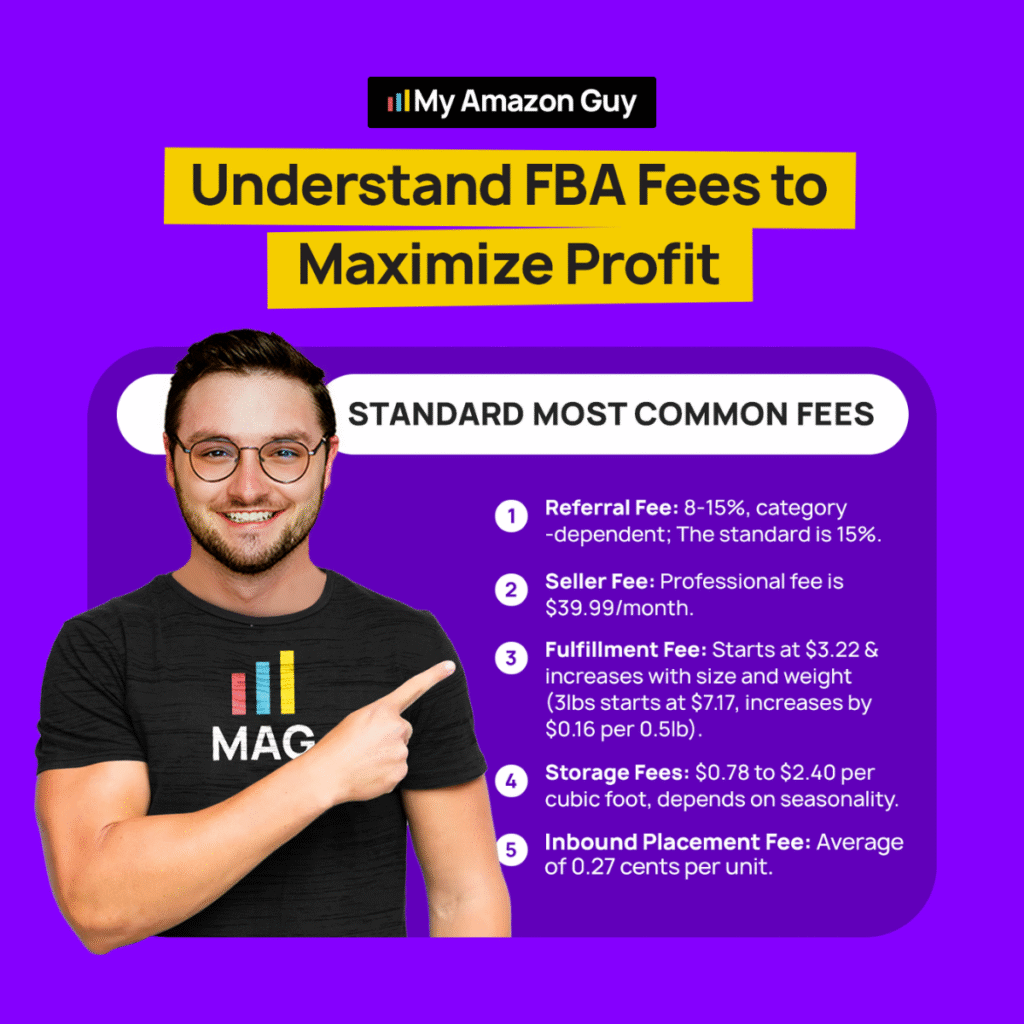
Do you think your Amazon seller metrics should only be about revenue? Think again. If your sales look great but your profit margins are gasping for air, it’s time to face reality.
When Amazon sellers measure success, they usually obsess over total revenue, the big, shiny number that looks great on a dashboard. But that number doesn’t tell the whole story because if you’re not tracking what’s left after Amazon fees, ad costs, and returns, you’re not running a business, you’re running a charity for Jeff Bezos.
Profit is what keeps your business alive, and understanding it is what separates sustainable brands from struggling ones. That’s why it’s time to focus less on bragging about sales and more on learning how much you actually keep.
In this blog, our Amazon agency will break down why focusing on revenue alone can be misleading and show which Amazon seller metrics truly reflect profit. We will also explain how to identify hidden profit killers, calculate contribution margin, and implement strategies to improve your bottom line.
Table of Contents
Stop Guessing, Start Knowing Your Profits
Track the right Amazon seller metrics and uncover which products are truly profitable. Take control of your bottom line today.
Revenue vs Profit: What Most Amazon Sellers Get Wrong
Revenue is the total money your Amazon store earns before a single fee is deducted. It’s the flashy number you brag about in seller groups, but it doesn’t tell you how much you actually keep.
Profit, on the other hand, is what’s left after Amazon takes its cut, including referral fees, FBA costs, ad spend, shipping, storage, and COGS. That’s the money that keeps your lights on and funds your next inventory order.
Focusing only on revenue creates a false sense of success because high sales don’t always equal high earnings. A product pulling in $100,000 a month might actually be losing money once all expenses are factored in.
Amazon rewards growth, but your accountant rewards profit. Understanding the difference ensures you make decisions that actually sustain and grow your business.
The Hidden Profit Killers on Amazon
Knowing what kills your profits is the first step to actually increasing them, yet many sellers still wonder why their sales are high but their bank account isn’t reflecting it. The truth? Profit leaks are everywhere, often hiding in plain sight.
Here are the biggest hidden profit killers every Amazon seller should be watching out for:
- Amazon Fees
Referral, FBA, and storage fees add up fast and can quietly drain your margins. - Advertising Costs
Overspending on PPC or targeting the wrong keywords can eat your profits faster than you realize. - Pricing Pressure
Competing on price alone forces you to cut margins just to stay visible in search results. - Poor Inventory Management
Overstocking leads to storage fees, while understocking causes missed sales and ranking drops. - Product Returns
Refunds, restocking, and damaged returns can erase profits from otherwise good months. - High Cost of Goods Sold
Rising supplier or manufacturing costs reduce your room for profit even before you make a sale. - Inefficient Marketing
Running ads or promotions without tracking ROI wastes spend that could be improving your bottom line.
Why Contribution Margin is the Real Indicator of Product Health
Revenue might tell you how much you’re selling, but contribution margin tells you how much you’re actually earning from each product. It’s the metric that separates profitable products from the ones just pretending to be.
Contribution Margin (CM) measures how much money a product contributes to covering your fixed costs and generating profit after subtracting all variable expenses. The formula is simple: (Revenue – Variable Costs) ÷ Revenue = CM%.
This metric matters more than gross profit or total revenue because it shows the real efficiency of each product. Two products can have similar sales numbers but completely different profit outcomes.
For example, Product A might generate $50,000 in revenue with a 10% CM, while Product B makes $30,000 with a 35% CM. Product B is the healthier one because it contributes more profit per sale and is more sustainable long-term.
When you understand your contribution margin, you stop guessing which products to scale since you know. It’s the difference between running your business on assumptions and running it on strategy.
Turn Revenue Into Real Profit
Learn how contribution margin and profit-focused strategies can transform your Amazon business. Make smarter decisions with data, not assumptions.
How to Improve Your Profitability on Amazon (Beyond Just Raising Prices)
There are plenty of ways for Amazon sellers to improve not just their revenue, but their overall profitability as well. While every business is different, there are proven strategies that can help you cut unnecessary costs, optimize operations, and keep more of what you earn.
Tip 1: Audit Your Fees Regularly
Amazon doesn’t make it easy to keep track of all the fees they charge, and that’s exactly why you should. Regularly auditing your fees, including referral, FBA, storage, advertising, and refund deductions, helps you catch unnecessary costs caused by packaging inefficiencies, weight misclassifications, or outdated listings.
Cross-checking your fees against your revenue and contribution margin lets you identify which products are eating into profits and which are genuinely profitable. Regular audits give you a clear picture of your bottom line, so you can make informed decisions about pricing, inventory, and marketing.

Tip 2: Adopt a Holistic Strategy
Many Amazon sellers manage PPC, inventory, and finances in isolation, thinking each area can run on its own. This siloed approach is fundamentally flawed because one action, like aggressive ad spending, can inadvertently spike FBA fees or create inventory shortages that hurt profit.
A holistic strategy means coordinating all aspects of your business, PPC, SEO, inventory, and financial planning, so every decision supports overall profitability. When your teams or services communicate and work together, you minimize hidden costs and make smarter, profit-driven decisions across the board.
Tip 3: Focus on Profit-Driven KPIs
Many Amazon sellers obsess over gross revenue, traffic, or page views, assuming higher numbers automatically mean success. These “vanity Amazon seller metrics” can be misleading because they don’t show how much money is actually hitting your bottom line.
Instead, prioritize KPIs that reflect true profitability, like contribution margin, net profit, TACoS (Total Advertising Cost of Sale), and Inventory Performance Index (IPI). Tracking these metrics regularly helps you make smarter decisions, scale the right products, and identify areas where costs are quietly eating into profits.
Tip 4: Align Your PPC Strategy with Profit
Focusing solely on lowering ACoS can be tempting, but it can backfire if higher sales lead to stockouts, over-purchasing, or inflated FBA fees. Many sellers fall into this trap, thinking that more sales always equals more profit, when the reality is often the opposite.
Instead, set your Amazon PPC targets based on contribution margin and overall profitability, not just cost-per-sale or raw sales volume. This approach ensures your advertising spend drives real profit, keeps inventory manageable, and avoids creating hidden costs that eat into your margins.
Tip 5: Optimize Inventory to Avoid Hidden Costs
Poor inventory management can quietly drain profits through stockouts, which lead to lost sales and lower search rankings, or over-purchasing, which racks up expensive long-term FBA storage fees. Many sellers underestimate how much these issues can impact their bottom line until it’s too late.
Proactive inventory management means forecasting sales accurately and balancing stock levels to support consistent sales velocity. Keeping inventory aligned with demand reduces storage fees, prevents missed opportunities, and protects your overall profitability.
Tip 6: Partner with a Profit-Driven Amazon Agency
Hiring an agency that focuses on profitability helps sellers dig deep into their financial data to uncover what’s truly driving or draining their profits. Instead of managing each area in isolation, a profit-driven team ensures every strategy supports your bottom line.
Look for an agency that offers an integrated approach, managing SEO, PPC, product design, and catalog optimization under one roof. When all aspects of your Amazon business work together, you minimize hidden costs, prevent conflicting strategies, and maximize overall profit.
Frequently Asked Questions
What’s the difference between revenue and profit on Amazon?
Revenue is the total money your store earns from sales, while profit is what’s left after subtracting all expenses like Amazon fees, advertising, shipping, storage, and cost of goods sold. Profit is the true measure of your business’s financial health.
How can I check my Amazon seller metrics?
You can view your key performance metrics in Amazon Seller Central, including revenue, FBA fees, advertising spend, and returns. Cross-reference these with contribution margin and profit KPIs to see which products are actually profitable.
Can hiring an Amazon agency really improve my profits?
Yes. A profit-driven Amazon agency aligns all aspects of your business, so strategies work together to maximize profit rather than just sales.
Stop Chasing Vanity Metrics and Focus on Real Profit
Many sellers don’t truly understand which Amazon seller metrics matter, leaving them unsure whether they’re actually profiting. Without this clarity, it’s easy to make uninformed decisions that hurt your bottom line.
This guide is designed to help sellers focus on the metrics that actually reflect profitability, like contribution margin and TACoS. By tracking the right numbers, you can make informed decisions, scale the right products, and run a healthier, more sustainable Amazon business.
Looking for a profit-driven Amazon Agency to partner with? Contact our full-service Amazon agency and let our team help you uncover hidden profit leaks, optimize your Amazon seller metrics, and grow your business sustainably.
Scale the Right Products for Profit
Stop chasing high-revenue items that aren’t profitable. Focus on products that grow your business sustainably.



